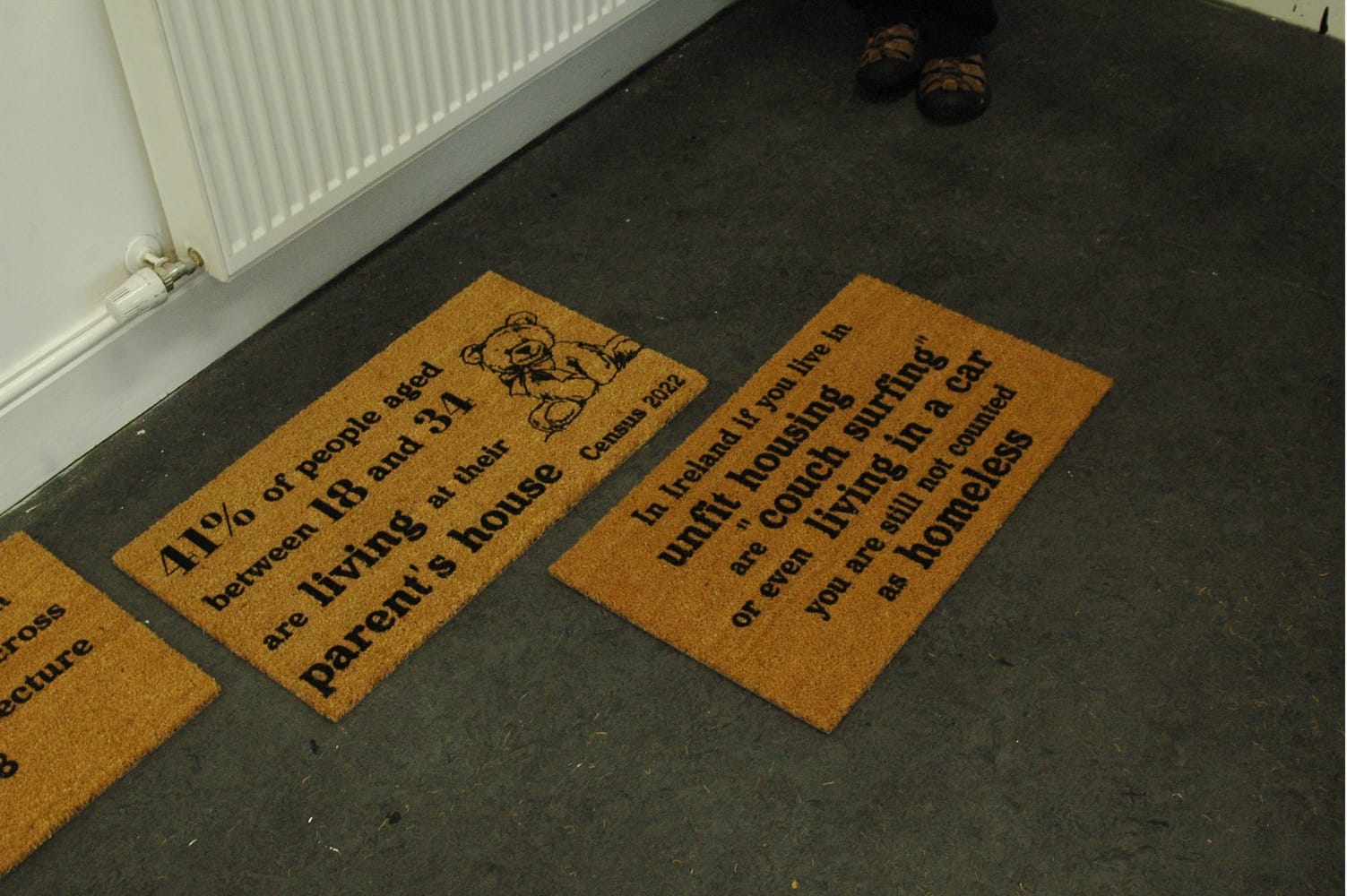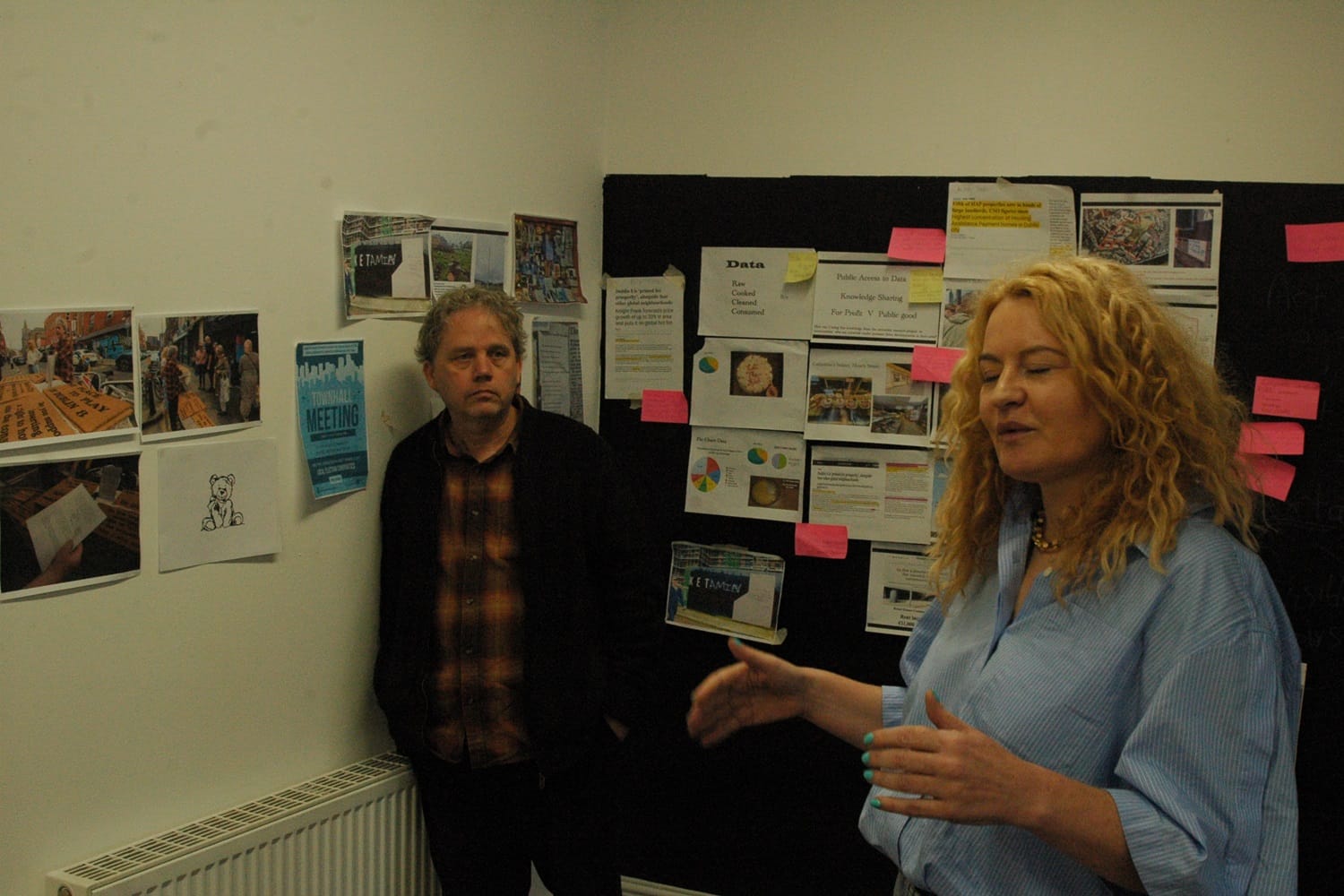What’s the best way to tell area residents about plans for a new asylum shelter nearby?
The government should tell communities directly about plans for new asylum shelters, some activists and politicians say.
Artist Augustine O’Donoghue and author Conor McCabe made 50 of the mats and gave them away on Meath Street recently. From there, they spread out.

Around the corner from Newmarket outside one of the pebbledash houses on Oscar Square, Mary Ryder’s doormat has a pointed greeting.
“Sip a coffee while taking in the breathtaking views across the neoliberal architecture of Dublin 8,” it reads.
Ryder isn’t usually one for doormats, she said on Thursday evening, walking through her kitchen.
She’s only ever had one other. “But it was so rotten after a while that I gave up on it.”
And, there was never another that she liked, she says. “They all say ‘Welcome’ with pretty little flowers or something like that.”
Not, that is, until she spotted the series of mats created recently by artist Augustine O’Donoghue and author and researcher Conor McCabe. They actually made sense, she says.
“This is what we talk about all the time here, saying, ‘Oh god, did you see what they’re building next?’” says Ryder.
From her garden, the appeal of the mat becomes quickly clear. Over the back wall, a large white crane occupies a chunk of the blue sky.
The mat is fitting because her neighbourhood is awash with hotels and student accommodation, she says, as well as coffee.
She’s a big coffee drinker, and the Liberties is an area with many, many coffee houses, she says. “It has more than you could possibly need or want, and it has all the many different types.”
Still, so many of the artisanal cups of coffee come part and parcel with the gentrifying process, she says. “I want the coffee. But what the pay-off is for a decent cup of coffee is this ugly architecture. Dark and brown and grey brutal stuff.”
Ryder’s was one of about 50 mats that O’Donoghue and McCabe have created in the lead-up to the local and European elections on 7 June.
Collectively titled “Artwork in Anticipation of Door-Knocking Politicians”, each of the mats bears one of 18 different messages, drawing from census data, local graffiti, and historic quotations.
Along the walk up to St Andrews Community Centre in Rialto, many of the brown doormats on Reuben Street extend pleasant greetings. A simple “Welcome.” Or, “Bee our guest”.
In O’Donoghue and McCabe’s workspace at the centre, one of their doormats appears cosy at first glance, with a smiling teddy bear.
But it also has a 2022 census statistic, noting that 41 percent of people nationwide between the ages of 18 and 34 are living with their parents.
These mats are the opposite of those inviting a guest to leave their troubles at the door.
The doorstep becomes a political space in the lead-up to an election, O’Donoghue said on Friday morning. “You’re coming in and political choices are being made there, and arguments are being had.”

She had been stewing on the idea of the mats for several months. It jumped back into her head a fortnight ago, she says.
“Election fever started to come in, and I started to think about what issues people are talking about on the doorsteps at the moment,” says O’Donoghue.
The pair gathered their messages from different sources, creating a narrative of resistance within Dublin 8, past and present, O’Donoghue says. “It was a way of not just using our own voice, but kinda saying these voices are out there.”
They took one line, “Still Waiting For The Trickle Down”, from Liberties SOS, an Instagram page which highlights gentrification in Dublin 8.
Another, “No Place To Play In Dublin 8” was found spray-painted on a sign outside the closed Donore Avenue Community Centre.
A third mat recreates a piece of graffiti outside on the hoardings that were up around the Newmarket Yard development, which said that nurses, teachers and bus drivers couldn’t afford to pay €2,400 a month in rent.
Meanwhile, the duo used a quotation from the Easter Rising and trade union leader James Connolly: “To remedy the evils of city life the citizens must own the city.”
It was chosen to illustrate the continued relevance of his analysis of housing in Ireland, says McCabe.
“What was going on in the 1890s is still going on today in Dublin 8. That then was a for-profit housing model, very similar to what is put forward now,” he says.
While all mats were site specific, some were more specific than others.
The Connolly mat, before it was given away, was set down on the site of 54 Pimlico, a tenement house where the republic and socialist politician lived in the 1890s, McCabe says.
Today, the site is a car park outside a set of council flats. That transition from tenement to public housing, the duo both agree, is something that would likely have pleased Connolly.
On 21 May, O’Donoghue and McCabe took their stack of doormats onto Meath Street, handing them out for free to passers-by.
They were grabbed straight away, because they were expressing what people in the neighbourhood are feeling, says Ryder. “People wanted them, and it wasn’t that they wanted a free mat. They resonated with people, because they were so well researched.”
Says O’Donoghue: “We’ve been inundated with people looking for them now.”
Ryder says she wants to nail hers to the doorstep. “Because I’m afraid someone will take it. Dead serious.”
As site-specific art, which only works when it is on someone’s doorstep, “Artwork in Anticipation of Door-Knocking Politicians” relies on community engagement.

“It’s kind of symbiotic,” says Abaigeal Meek, creative director of The Pimlico Project, a video and photography studio and one of the people behind the Liberties SOS Instagram page.
This is a series that validates how people are feeling at the moment, she says. “It takes a conversation that is being had a lot online and brings it back to the street.”
Says Meek: “But it also brings back the politics of the sign, because there is such a focus on social media, that we forget how something that simple as a sign can become that political.”
She points to the sign outside the Donore Avenue Community Centre as a good example here. It was a simple message, asking for more space to play, she says. “It was in a childlike scrawl almost because that visual really connects with us.”
Something as up-front and accessible as a doormat is a powerful tool for communication, she says.
“Visually, it can be hard to convey homelessness or the housing crisis,” she says, “and this is just a lovely way of connecting with people, which resonated in a way because a mat is gentle, and something we all know.”
Get our latest headlines in one of them, and recommendations for things to do in Dublin in the other.